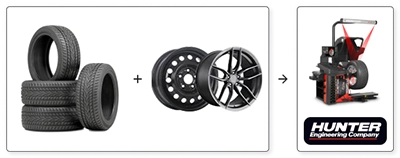Tire Quarter Test: Check Your Winter Tires and Get Ready for the Upcoming Season

As winter approaches, ensuring your vehicle is prepared for icy and snowy conditions is crucial for safe driving. One of the most important aspects of winter readiness is having tires with adequate tread depth. This article will introduce the quarter test, a simple and effective method to check your tire tread depth, and provide tips on how to take photos of your tires if you're looking to sell them.
What is the Tire Quarter Test?
The quarter test is an easy way to measure your tire tread depth using a standard Canadian quarter with a caribou on the tails side of the coin. The test helps you determine if your tires are still good or if they need to be replaced before the winter season.
Why Tire Tread Depth Matters in Winter
Tire tread depth is essential for maintaining traction, braking, and overall vehicle control on icy and snowy roads. Adequate tread depth helps channel snow and water away from the tire, reducing the risk of skidding and improving handling.
How to Perform the Quarter Test
- Get a Canadian Quarter: Use a standard Canadian quarter featuring a caribou on one side.
- Insert the Quarter: Place the quarter into the tread groove of your tire with the caribou's head facing down.
- Evaluate the Tread Depth:
- If the tread covers the caribou's muzzle, your tires have more than 6/32nd of an inch of tread depth remaining, which is considered safe.
- If the caribou's muzzle is visible, your tire tread is worn to 6/32nd of an inch or less, and it's time to consider replacing your tires.
Most tire manufacturers recommended changing your tires when they have only 4/32nd of tread depth remaining, and it's illegal to run tires with less than 2/32nd of remaining tread depth.
Therefore, if the tire groove barely touches the caribou's muzzle, although they are still considered legal and have sufficient tread remaining, it's important noting that the tire's performances will not be optiomal in snowy conditions and that this will most likely be their last season.

Interpreting the Results
Once you've performed the quarter test using a Canadian quarter, understanding the results is straightforward. If the tread covers the caribou's muzzle, it means your tires have more than 6/32 of an inch of tread depth remaining. This is a good sign, indicating that your tires have sufficient tread depth to provide safe traction and handling in winter driving conditions. Proper tread depth helps to channel snow and water away from the tire, reducing the risk of skidding and enhancing vehicle control on icy and snowy roads.
On the other hand, if the caribou's muzzle is visible when you insert the quarter into the tire tread, it signifies that the tread depth has worn down to 6/32 of an inch or less. This is a clear indication that your tires are no longer suitable for safe winter driving. Tires with insufficient tread depth can compromise your vehicle's grip on the road, especially in adverse weather conditions, increasing the risk of accidents. In this case, it's time to consider replacing your tires to ensure your safety during the winter season.
Taking Photos to Sell Your Tires
When you're looking to sell your used tires, presenting them in the best possible light can significantly attract potential buyers. High-quality, detailed photos are essential for showcasing the condition and tread depth of your tires. To achieve this, start by taking photos in a well-lit area. Natural light is ideal, but if that's not possible, use bright artificial lighting to ensure the details of the tread are clearly visible.
Choose a clean, uncluttered background for your photos. A neutral backdrop, such as a plain wall or garage floor, will make the tires stand out and prevent distractions. This helps potential buyers focus on the condition of the tires rather than any surrounding clutter.
Capture close-up shots of the tire tread with the quarter inserted to demonstrate the depth. This provides a clear visual reference of the tread condition, helping buyers assess whether the tires meet their needs. Additionally, take multiple photos from different angles, including full tire shots and side profiles, to give a comprehensive view of the tires. This transparency builds trust with potential buyers, as they can see exactly what they are purchasing.
By following these tips, you can effectively present your used tires in a way that highlights their quality and tread depth, making them more appealing to buyers looking for reliable, second-hand tires.

Additional Tips for Preparing for Winter
Ensuring your vehicle is ready for winter involves more than just checking tire tread depth. Here are some additional tips to help you prepare for safe winter driving.
Firstly, regularly checking your tire pressure is crucial. Cold weather can cause tire pressure to drop, leading to under-inflated tires. Under-inflation can negatively affect your vehicle's handling and increase tire wear. Make it a habit to check your tire pressure at least once a month, and always before long trips. Refer to your vehicle’s manual for the recommended tire pressure and adjust accordingly to maintain optimal performance and fuel efficiency.
Secondly, if you live in an area that experiences harsh winter conditions, consider switching to winter tires. Unlike all-season tires, winter tires are specifically designed to perform better in low temperatures, ice, and snow. They have a softer rubber compound and deeper tread patterns, providing better grip and traction. Investing in a set of winter tires can significantly improve your safety on the road during the winter months.
Lastly, scheduling a maintenance check with a professional mechanic is essential before the winter season. A comprehensive inspection should include checking your vehicle’s battery, brakes, lights, and windshield wipers, ensuring they are all in good working condition. The mechanic can also check your antifreeze levels and top up other essential fluids. This proactive approach can help identify potential issues before they become major problems, ensuring your vehicle is fully prepared for winter driving conditions.
By following these additional tips, you can enhance your vehicle's performance and safety, making your winter driving experience more reliable and stress-free.
Regularly checking your tire tread depth using the quarter test is a simple yet effective way to ensure your tires are safe for winter driving. By following the steps outlined in this article, you can easily determine if your tires need to be replaced and take great photos if you're looking to sell them. Preparing early for the winter season will help you enjoy safe driving all winter long.
If you've performed the caribou muzzle test and found that your tires need to be replaced, don't hesitate to contact one of our experts. They will assist you in choosing the right tire for your vehicle and your specific needs, or scroll through the many options we offered here at PMCtire by entering your vehicle information here!
Dominic Vaillancourt
Automotive expert & Spokesperson


